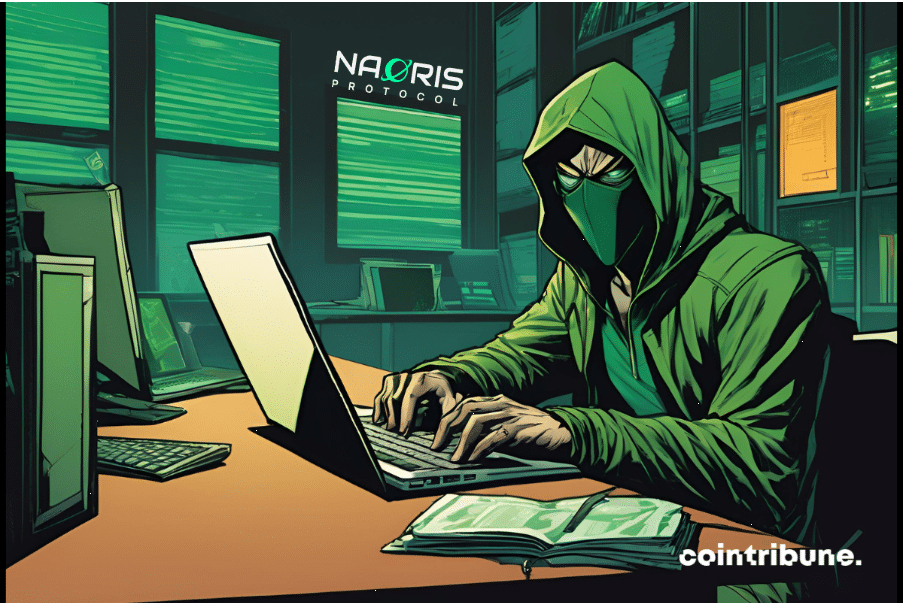Zero Trust and Blockchain: The New Era of Cybersecurity
Cyber threats are multiplying in a world where digital systems are becoming increasingly interconnected. Traditional architectures, based on implicit trust and centralized points of control, are no longer sufficient to protect data and critical infrastructures. The Zero Trust model emerges as a clear response to these flaws: it relies on continuous verification, granting no user or device default trust. To go further, blockchain offers an ideal foundation. With its Sub-Zero architecture, Naoris Protocol turns this promise into reality. It creates a decentralized, post-quantum, self-validating infrastructure capable of securing both Web2 and Web3 systems in real time, without a single point of failure.

In Brief
- Traditional centralized security models are no longer effective in a world of interconnected digital systems and quantum threats.
- The Zero Trust model verifies every user and device by default, but centralized implementations introduce new vulnerabilities.
- Blockchain reinforces Zero Trust with distributed, immutable, and verifiable trust, but legacy chains face scalability and post-quantum limitations.
- Naoris Protocol introduces a Sub-Zero Layer that operates beneath blockchain infrastructures, enabling seamless, post-quantum, real-time validation.
- Its dPoSec and Swarm AI technologies transform every device into a self-validating node within a decentralized Trust Mesh.
- Already in use, Naoris secures IoT, smart cities, Web3 platforms, and critical infrastructures without requiring technical overhauls.
The Zero Trust model in cybersecurity: its foundations and current limits
In the face of rising cyber threats, traditional security approaches are no longer adequate. Companies can no longer rely on protecting a fixed perimeter. Attacks can come from anywhere, sometimes even from within. The Zero Trust model offers a clear alternative: deny all default trust and verify every action precisely.
Origins and core principles of Zero Trust
The concept of Zero Trust is built on a simple rule: “Never trust, always verify.” No entity, internal or external to the network, is granted access without prior verification. Every user and device must prove its legitimacy before accessing resources.
The model uses several mechanisms: dynamic access control adjusts permissions based on context. Micro-segmentation isolates sensitive areas to prevent lateral movement in the event of a breach. Real-time monitoring detects any abnormal activity to trigger a rapid response.
These principles form a defense framework suited to today’s complex and mobile digital environments.
Why has Zero Trust become essential?
The rise of remote work, the proliferation of connected devices, and the adoption of cloud technologies are reshaping enterprise networks. The traditional security perimeter is vanishing.
Cybercriminals no longer focus solely on central servers. They exploit endpoint vulnerabilities to infiltrate discreetly. In this context, the Zero Trust model secures every access point. It increases network-wide vigilance, without exception.
The limits of centralized Zero Trust implementations
Despite its advantages, the Zero Trust model struggles when built on centralized architectures. Central control points themselves become critical targets. Once compromised, they open the door to the entire network. Latency, scalability issues, and the costs of centralized data processing slow down implementation.
Moreover, reliance on proprietary cloud solutions raises concerns about sovereignty, confidentiality, and resilience. Zero Trust needs a more reliable foundation to reach its full potential.
Blockchain as a catalyst for Zero Trust
Zero Trust relies on constant verification of identity, integrity, and behavior. To operate effectively, it needs a reliable, transparent, and resilient support system. This is where blockchain technology becomes a critical enabler. It naturally aligns with the core requirements of Zero Trust.
An architecture based on distributed trust
Blockchain relies on a ledger shared among all participants. This ledger cannot be altered without collective validation. Every operation is immutably recorded, and cryptography ensures data authenticity. Decentralized consensus replaces central authorities and validates actions without a trusted third party.
Transparency is native: anyone can verify transactions at any time. This strengthens accountability and reduces manipulation risks.
How does blockchain reinforce Zero Trust?
Blockchain removes single points of failure. No authority controls the entire system. Data remains accessible but cannot be falsified. Integrity becomes verifiable, publicly or privately, depending on need.
Authentication no longer depends on a central server, as each node locally verifies the network’s rules. This reinforces the Zero Trust model by providing autonomous, continuous, and resilient validation.
The limits of traditional blockchains for advanced cybersecurity
However, traditional blockchains face limitations. Their throughput remains low compared to the demands of large-scale networks. They’re unprepared for post-quantum attacks. Integration with Web2 systems is also complex. These challenges hinder their adoption as the core foundation for global Zero Trust.
Naoris Protocol: a new Sub-Zero Level Zero Trust infrastructure
Naoris Protocol redefines trust and security by deploying an infrastructure that surpasses the limits of traditional Zero Trust. It’s not about adding a layer of security, it’s about building a structural base designed from the ground up to operate without implicit trust. This architecture operates beneath conventional blockchain layers and enables continuous validation of digital systems.
The Sub-Zero Layer: a new trust foundation below Layer 0
Naoris Protocol introduces the Sub-Zero Layer, an innovative infrastructure operating beneath blockchain layers L0, L1, and L2. This invisible layer integrates with existing systems without disrupting their operation. It doesn’t compete with blockchains; it reinforces them.
The Sub-Zero Layer provides a continuous, post-quantum validation layer to all architectures, Web2 or Web3. No major modifications are needed. EVM-compatible protocols can adopt Naoris without a hard fork, accelerating their shift toward sustainable cybersecurity.
dPoSec: real-time validation of device cyber integrity
The dPoSec (Decentralized Proof of Security) consensus validates each connected device’s cyber integrity in real time. Every terminal, server, or object becomes an active validator node, proving its integrity with every protocol cycle. Compliant nodes earn rewards, while compromised ones are penalized.
This incentive mechanism turns the entire network into a distributed and autonomous validation system.
Swarm AI: adaptive coordination and swarm-based learning
Swarm AI complements the model, relying on a multitude of lightweight agents distributed across the network. Each agent monitors local activity and shares its observations with others.
In the event of a threat, the entire system reacts instantly, adapting its defense without relying on a single decision-making center. This coordination creates a living network capable of responding to complex attacks.
The Decentralized Trust Mesh: toward distributed zero trust
Naoris establishes a Trust Mesh, a decentralized security grid that replaces static perimeters. Every device becomes a validator, playing a direct role in global cybersecurity.
This model is non-hierarchical. It eliminates structural weaknesses.
It applies equally to cloud, IoT, DEXs, bridges, and DAOs. The result: distributed Zero Trust, operational at scale without compromising speed or interoperability.
Comparing centralized and decentralized Zero Trust models
Zero Trust can be deployed in various ways. Many enterprises choose centralized solutions, often from cloud providers. However, this centralization creates new vulnerabilities. In contrast, Naoris Protocol implements a distributed model that addresses these flaws at the architectural level.
Centralization = structural fragility
In centralized systems, monitoring relies on a few control points, ideal targets for cyberattacks. Intrusion detection is delayed, as data must be routed to a central analyzer.
Endpoints, often diverse and scattered, can escape constant vigilance. The system remains blind to weak signals.
Confidentiality is also a concern. Sensitive data flows through external servers, governed by unclear rules. Governance remains centralized, with decisions made by isolated actors, lacking transparency or coordination.
Decentralized Zero Trust with Naoris: native security and systemic resilience
Naoris Protocol takes a radically different approach. It distributes validation across all network nodes. Each device verifies its own and others’ integrity in real time. This continuous self-validation builds trust without centralized intervention.
Transparency is native. Security proofs are visible, verifiable, and stored on post-quantum infrastructure.
The protocol supports Web2 and Web3 architectures alike, requiring no fundamental system changes. Its post-quantum resilience ensures structural defense against future threats, including those posed by the Q-Day.
Impacts for organizations and use cases
Naoris Protocol is more than a concept; its post-quantum infrastructure is already being used in critical sectors. It integrates with existing architectures while adding a distributed, self-validating security layer.
Securing IoT, cloud, and critical infrastructure
Smart cities, healthcare systems, and Industry 4.0 rely on countless connected devices. Each is a potential entry point for cyberattacks. Naoris transforms each device into a validator node, monitors its integrity, and alerts the network in case of abnormal behavior.
This protects sensitive data and ensures compliance with regulatory standards. It adapts to complex environments without requiring major overhauls.
Enhancing Web3 security without technical overhauls
The protocol integrates directly with EVM-compatible blockchains, no migration or hard fork needed. It secures validators, DEXs, bridges, and DAOs. Smart contracts run only on verified healthy nodes, reducing risks of collusion, corruption, or failure in decentralized systems.
Rapid Adoption
Naoris’s testnet recorded over one million nodes in just 30 days. It processed more than 133 million post-quantum transactions. It also identified 440,000 threats, surpassing cybersecurity industry leaders during that period.
These results confirm the infrastructure’s effectiveness, scalability, and relevance.The distributed Zero Trust model offers a coherent response to the limitations of centralized security systems. By leveraging blockchain, it introduces continuous, transparent validation without a single point of failure. The shift toward post-quantum infrastructures is urgent in the face of emerging threats. Naoris Protocol provides a structured, interoperable solution designed to endure. Its Sub-Zero architecture, dPoSec consensus, and swarm intelligence place security at the heart of every digital interaction. As digital trust becomes strategic, Naoris is emerging as the decentralized cybersecurity standard for the next decade.

FAQ
The blockchain-native model eliminates dependency on any central authority. It relies on distributed, transparent, and tamper-resistant validation enhancing trust without compromising performance.
Yes. It integrates with Web2 systems like cloud, IoT networks, and critical infrastructures. It applies the same continuous validation logic without requiring blockchain migration.
Swarm AI coordinates real-time threat responses. It learns from node behavior and adapts defense mechanisms collectively, avoiding slow and inefficient manual interventions.
Maximize your Cointribune experience with our "Read to Earn" program! For every article you read, earn points and access exclusive rewards. Sign up now and start earning benefits.
Diplômé de Sciences Po Toulouse et titulaire d'une certification consultant blockchain délivrée par Alyra, j'ai rejoint l'aventure Cointribune en 2019. Convaincu du potentiel de la blockchain pour transformer de nombreux secteurs de l'économie, j'ai pris l'engagement de sensibiliser et d'informer le grand public sur cet écosystème en constante évolution. Mon objectif est de permettre à chacun de mieux comprendre la blockchain et de saisir les opportunités qu'elle offre. Je m'efforce chaque jour de fournir une analyse objective de l'actualité, de décrypter les tendances du marché, de relayer les dernières innovations technologiques et de mettre en perspective les enjeux économiques et sociétaux de cette révolution en marche.
The contents and products mentioned on this page are in no way approved by Cointribune and should not be interpreted as falling under its responsibility.
Cointribune strives to communicate all useful information to readers, but cannot guarantee its accuracy and completeness. We invite readers to do their research before taking any action related to the company and to take full responsibility for their decisions. This article should not be considered as investment advice, an offer, or an invitation to purchase any products or services.
Investment in digital financial assets carries risks.
Read more